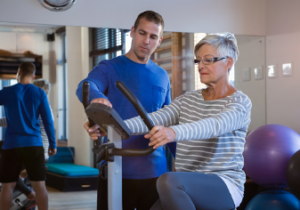Exercise physiologists are university-qualified allied health professionals specialising in therapeutic exercise and injury management. They also work to promote a healthy lifestyle through education and guidance.
Endurance training involves repeated contractions of skeletal muscles for long periods. This type of exercise elicits aerobic and anaerobic adaptations.
 The COVID-19 pandemic saw rapid changes to exercise physiology service delivery models, including increased telehealth services. This prospective cohort study will evaluate whether these modifications influenced client outcomes. For professional exercise physiology for joint health Woodville services, click here.
The COVID-19 pandemic saw rapid changes to exercise physiology service delivery models, including increased telehealth services. This prospective cohort study will evaluate whether these modifications influenced client outcomes. For professional exercise physiology for joint health Woodville services, click here.
Strength
Strength training involves using a heavy weight to tire your muscles after 12 to 15 repetitions. You aim to build muscle mass, increase strength and improve balance and endurance. A certified exercise physiologist will advise you on the best type of strength training to achieve your goals. They’ll also help you to perform your exercises correctly, minimising injury risk.
Research has shown that regular strength training improves physical functioning in people with chronic conditions like arthritis. However, starting slowly and building up your strength over time is essential. It will help you avoid injuries and ensure your body can adapt to the stress of increased activity.
Endurance
The ability to sustain physical activity for long periods is often called endurance. This skill must be developed, and it can take a lot of practice to improve. Whether you’re a runner or a weightlifter, having endurance can help you get more out of your workouts and improve your overall performance.
Endurance training involves repeated isotonic contractions of sizeable skeletal muscles over extended durations. This type of exercise typically uses a low to moderate intensity, and it’s common for people with chronic conditions or disabilities to perform endurance training as part of their rehabilitation programs. For professional exercise physiology for joint health Woodville services, click here.
Previously, it was believed that endurance and strength training elicited different adaptations in the body. Still, research has shown that both types of exercise can lead to similar aerobic and anaerobic fitness outcomes. It has led to a shift in how the medical community views endurance and strength training.
Flexibility
Inflexible muscles can lead to muscle and joint pain, making it more difficult for joints to move through their full range of motion. Increasing flexibility requires regular, careful stretching of the muscles and connective tissue (tendons, ligaments, and fascia).
Flexibility training increases a joint’s mobility and decreases the risk of injury, especially in weight-bearing joints such as the knees and hips. It also decreases the risk of lower back injuries and reduces the likelihood of ankle sprains.
Stretching is most effective after a workout or exercise and is most safe when performed with warm muscles. Extension can be done alone, with a partner, or with a professional exercise physiologist.
Knowing how to safely and effectively stretch is essential, which is why an exercise physiologist is the best person for the job. They are university-qualified allied health professionals with strict accreditation requirements specialising in exercise and injury rehabilitation. They work in hospital and rehabilitation settings, as well as privately with clients. For professional exercise physiology for joint health Woodville services, click here.
Balance
Exercise physiologists are university-qualified allied health professionals who create customised exercise programs for clients with chronic injuries and illnesses like arthritis and diabetes. They also provide advice and support to help people get active and improve their general well-being.
Balance is proprioceptive training that helps the body sense its position in space. It can reduce the risk of injury and improve athletic performance by teaching the body to move with greater control and speed on uneven surfaces.
To perform a simple balance exercise, stand six to eight inches away from a wall with your feet hip-width apart and focus on an object at eye level. Then, shift your weight through your hips to the left leg, keeping your belly button aligned with your hips. Repeat for up to 30 seconds. As your balance improves, slowly increase the distance from the wall. Do three to five sets. Be sure to warm up before performing this exercise with five to 10 minutes of walking, jogging in place or using cardio equipment.